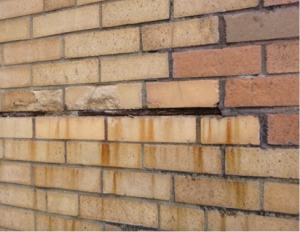Each week we’re bringing you an in-depth look at one of the standard conditions we encounter and document during inspections of buildings and civil structures.
Part 10: Pack Rust
Pack rust refers to the expansive corrosion of ferrous metals. This powerful mechanical force can break apart adjacent concrete and masonry. Pack-rusted fasteners and structural elements can cause the deterioration of adjacent brick, stone, terra cotta, and concrete. In structural iron and steel, pack rust leads to overall structural weakening.
Iron oxidizes in the presence of oxygen and water, often accelerating with exposure to salt, and expands rapidly as it corrodes. When exposed surfaces rust, the brittle corrosion product weathers away, but when rust occurs within a confined space – for example, within reinforced concrete or between two plates of a bridge truss – the rapidly expanding corrosion product forces apart surrounding materials. Where iron and steel fasteners were designed to be protected from the elements, this action causes more water to enter, creating a positive-feedback cycle of deterioration.
Next in this series: Displacement
Click here to see all posts in this series.
Click here for an index of all posts in this series, or download a pdf of the complete series.

